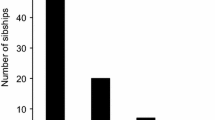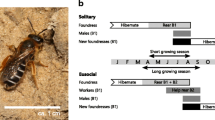Abstract
Colony structure and eusociality level of the sweat bee Lasioglossum (Evylaeus) duplex were studied in 2001 in Sapporo and Assabu, Hokkaido, northern Japan. Sakagami and his colleagues had also studied this species in Sapporo in 1957–1968. Brood size, sex ratio and queen–worker size dimorphism were geographically and temporally variable, indicating spatio-temporal variation at the eusociality level. Inseminated workers constituted only 7.9% of the populations in 1957–1968 Sapporo but about 60% in 2001 in Sapporo and Assabu. A few of the inseminated workers were believed to leave natal nests for independent colony founding. Thus, partial bivoltinism is likely in this sweat bee species. The presence of workers with developed ovaries and/or corpora lutea suggests the occurrence of worker oviposition.

Similar content being viewed by others
References
Breed MD (1976) The evolution of social behavior in primitively social bees: a multivariate analysis. Evolution 30:234–240
Cronin AL, Hirata M (2003) Social polymorphism in the sweat bee Lasioglossum (Evylaeus) baleicum (Cockerell) (Hymenoptera: Halictidae) in Hokkaido, northern Japan. Insectes Sociaux 50:379–386
Goukon K, Sakagami SF, Maeta Y (1986) Bionomic comparison of two populations of a eusocial halictine bee, Lasioglossum duplex, in northern Japan. Jpn J Ecol 35:587–600
Kukuk P, May B (1991) Colony dynamics in a primitively eusocial halictine bee Lasioglossum (Dialictus) zephyrum (Hymenoptera: Halictidae). Insectes Sociaux 13:87–92
Michener CD (1974) The social behavior of the bees: a comparative study. Harvard University Press, Cambridge
Ordway E (1966) The bionomics of Augochlorella striata and A. persimilis in eastern Kansas. J KS Entomol Soc 39:270–313
Packer L (1997) The relevance of phylogenetic systematics to biology: examples from medicine and behavioral ecology. Mém Mus Nat d’Hist Nat 173:11–29
Packer L, Knerer G (1985) Social evolution and its correlates in bees of the subgenus Evylaeus (Hymenoptera; Halictidae). Behav Ecol Sociobiol 27:339–344
Packer L, Sampson B, Lockerbie C, Jessome V (1989) Nest architecture and brood mortality in four species of sweat bee (Hymenoptera; Halictidae) from Cape Breton Island. Can J Zool 64:2325–2332
Richards MH (2000) Evidence for geographic variation in colony social organization in an obligately social sweat bee, Lasioglossum malachurum Kirby (Hymenoptera; Halictidae). Can J Zool 78:1259–1266
Richards MH (2001) Nesting biology and social organization of Halictus sexcinctus (Fabricius) in southern Greece. Can J Zool 79:2210–2220
Richards MH, Packer L (1995) Annual variation in survival and reproduction of the primitively eusocial sweat bee Halictus ligatus (Hymenoptera: Halictidae). Can J Zool 73:933–941
Sakagami SF (1977) Seasonal change of nest survival and related aspects in an aggregation of Lasioglossum duplex (Dalla Torre), a eusocial halictine bee (Hymenoptera: Halictidae). Res Popul Ecol 19:69–86
Sakagami SF, Hayashida K (1958) Biology of the primitive social bee, Halictus duplex Dalla Torre I. Preliminary report on the general life history. Annot Zool Jpn 31:151–155
Sakagami SF, Hayashida K (1960) Biology of the primitive social bee, Halictus duplex Dalla Torre II. Nest structure and immature stages (I). Insectes Sociaux 7:57–98
Sakagami SF, Hayashida K (1961) Biology of the primitive social bee, Halictus duplex Dalla Torre III. Activities in spring solitary phase. J Fac Sci Ser VI Zool 14:639–682
Sakagami SF, Hayashida K (1968) Bionomic and sociology of the summer matrifilial phase in the social halictine bee, Lasioglossum duplex. J Fac Sci Ser VI Zool 16:413–513
Sakagami SF, Michener CD (1962) The nest architecture of the sweat bees. University of Kansas Press, Lawrence
Soucy SL, Danforth BN (2002) Phylogeography of the socially polymorphic sweat bee Halictus rubicundus (Hymenoptera: Halictidae). Evolution 56:330–341
Wcislo WT, Danforth BN (1997) Secondarily solitary: the evolutionary loss of social behavior. Trends Ecol Evol 12:468–474
Wyman LM, Richards MH (2003) Colony social organization of Lasioglossum malachurum Kirby (Hymenoptera, Halictidae) in southern Greece. Insectes Sociaux 50:201–211
Acknowledgements
We express our sincere thanks to Dr. O. Tadauchi, Kyushu University, for his identification of our bee samples.
Author information
Authors and Affiliations
Corresponding author
About this article
Cite this article
Hirata, M., Cronin, A.L., Kidokoro, M. et al. Spatio-temporal variation of colony structure and eusociality level of the Japanese sweat bee Lasioglossum (Evylaeus) duplex (Hymenoptera: Halictidae). Ecol Res 20, 75–79 (2005). https://doi.org/10.1007/s11284-004-0005-x
Received:
Accepted:
Published:
Issue Date:
DOI: https://doi.org/10.1007/s11284-004-0005-x




